Research Assistant Cover Letter Examples And Template
Check out these research assistant cover letter sample and examples previously used by job seekers to land on job interviews as research assistant. Use our AI cover letter generator to create a personalized cover letter as research assistant.
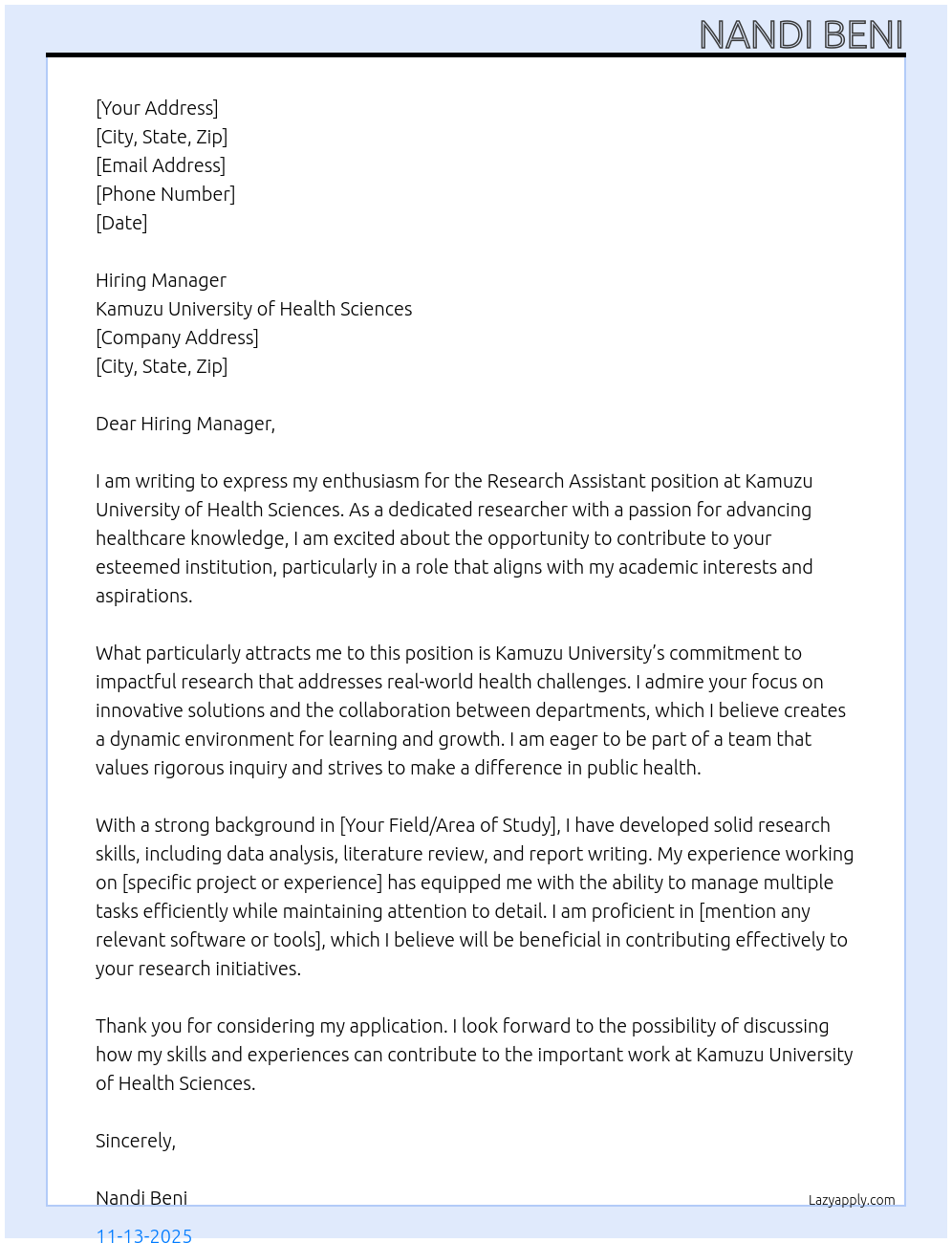
Research Assistant Cover Letter Examples

Research assistant Cover Letter At Kamuzu University of Health sciences
Kamuzu University of Health sciences
By Nandi Beni
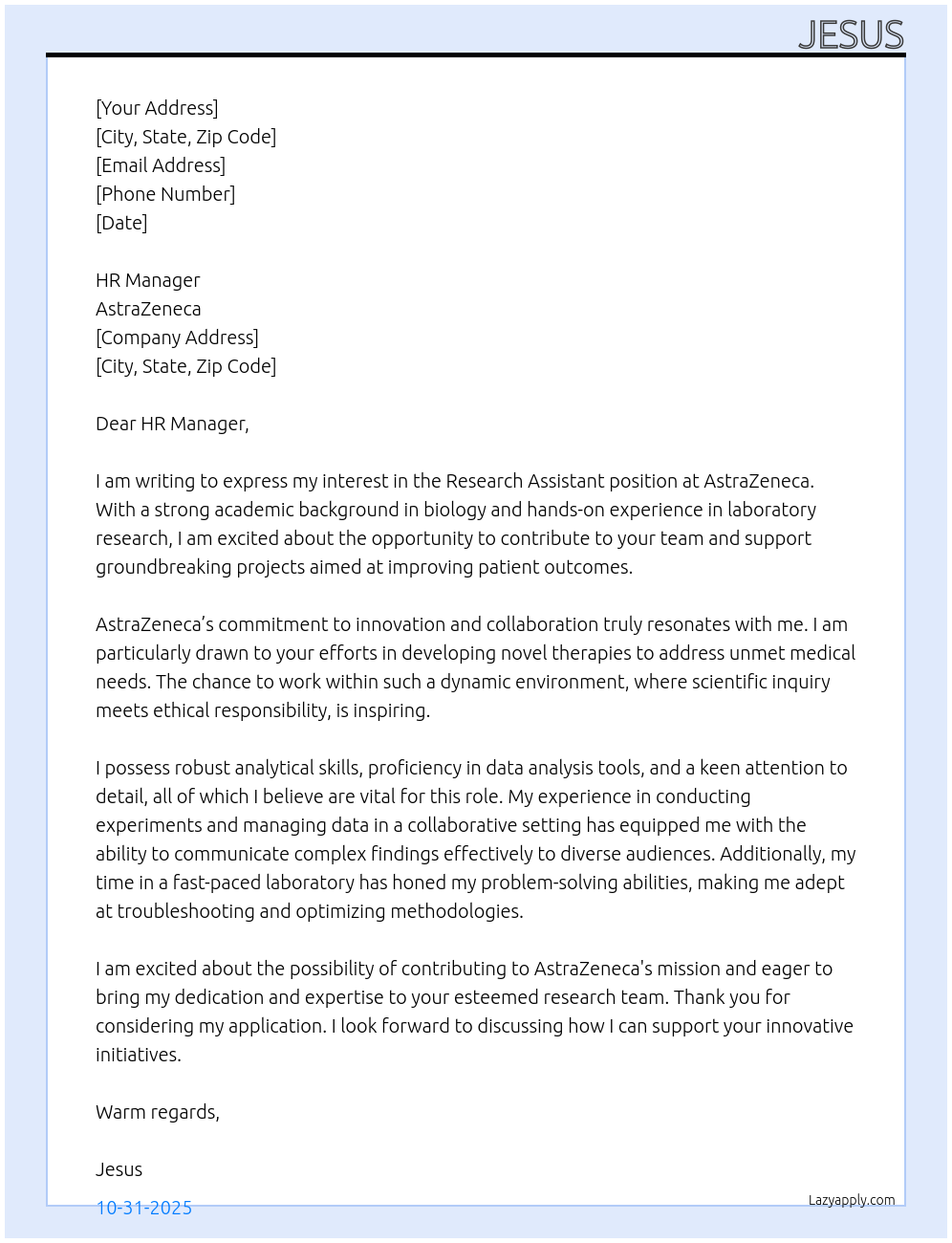
Research assistant Cover Letter At Aztra Zeneca
Aztra Zeneca
By Jesus
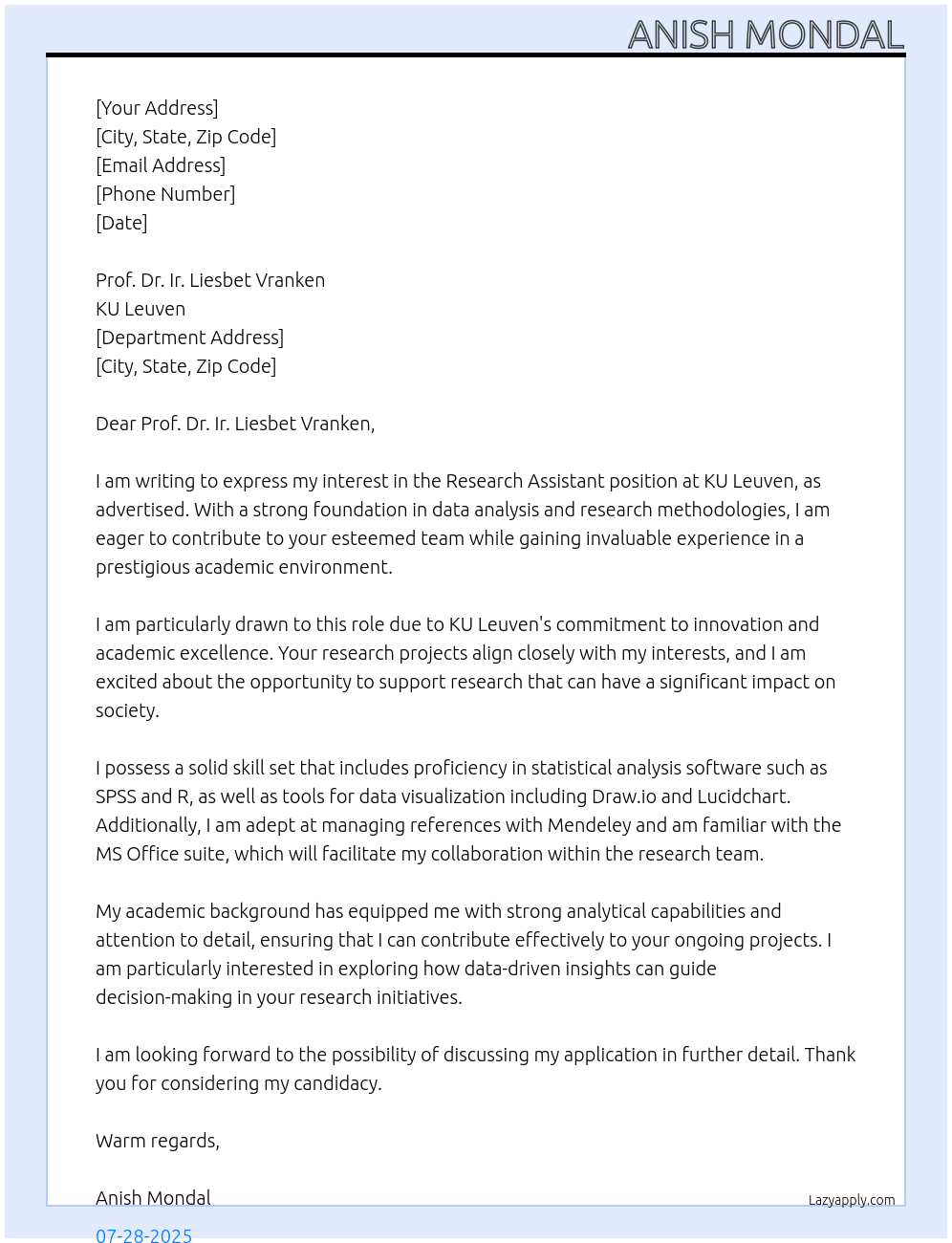
Research Assistant Cover Letter At Ku Leuven
Ku Leuven
Belgium
By Anish Mondal

Research Assistant Cover Letter At Renovate Biosciences Pvt. Ltd
Renovate Biosciences Pvt. Ltd
Hyderabad
By BOMMA VARSHA GOUD
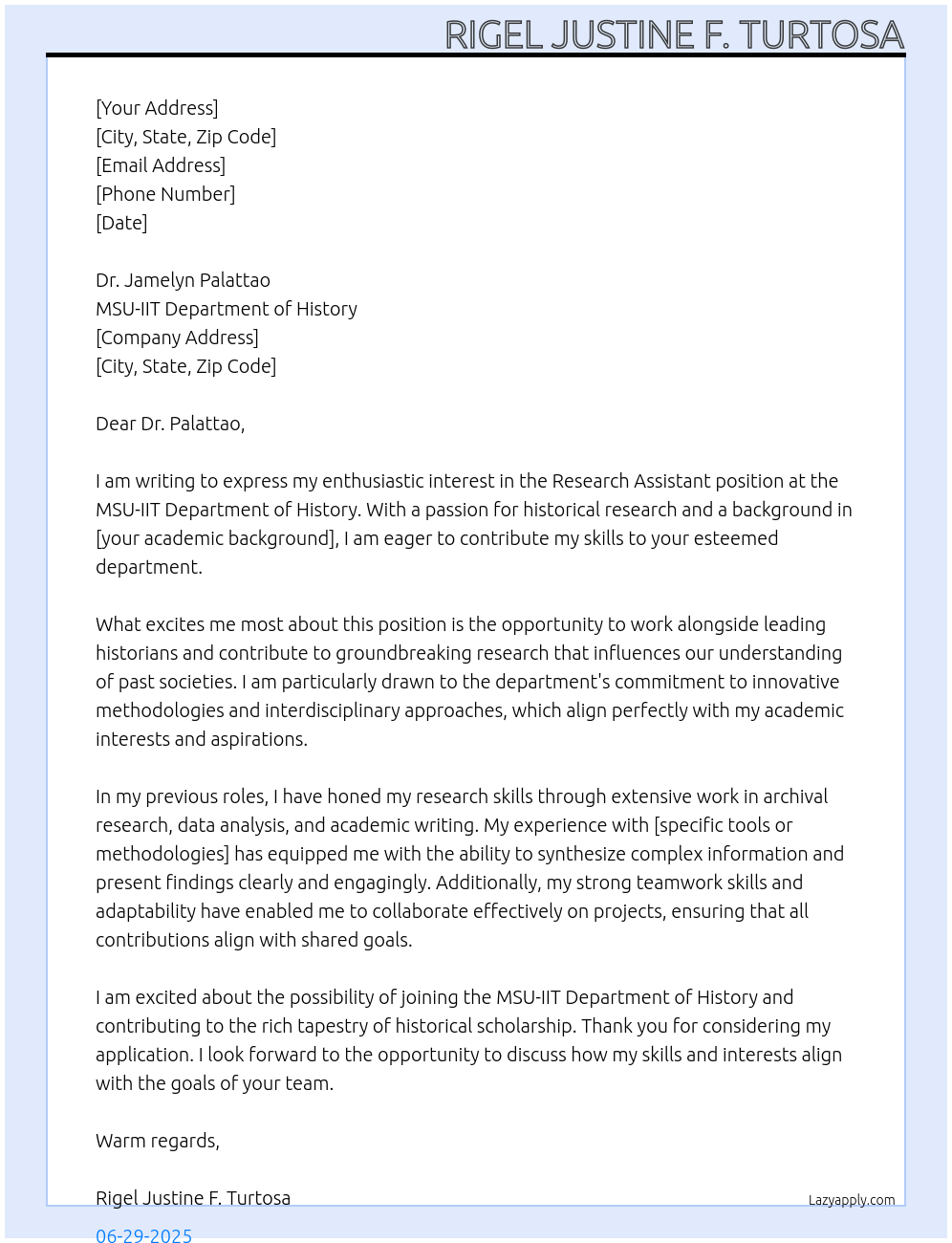
Research Assistant Cover Letter At MSU-IIT Department of History
MSU-IIT Department of History
By Rigel Justine F. Turtosa
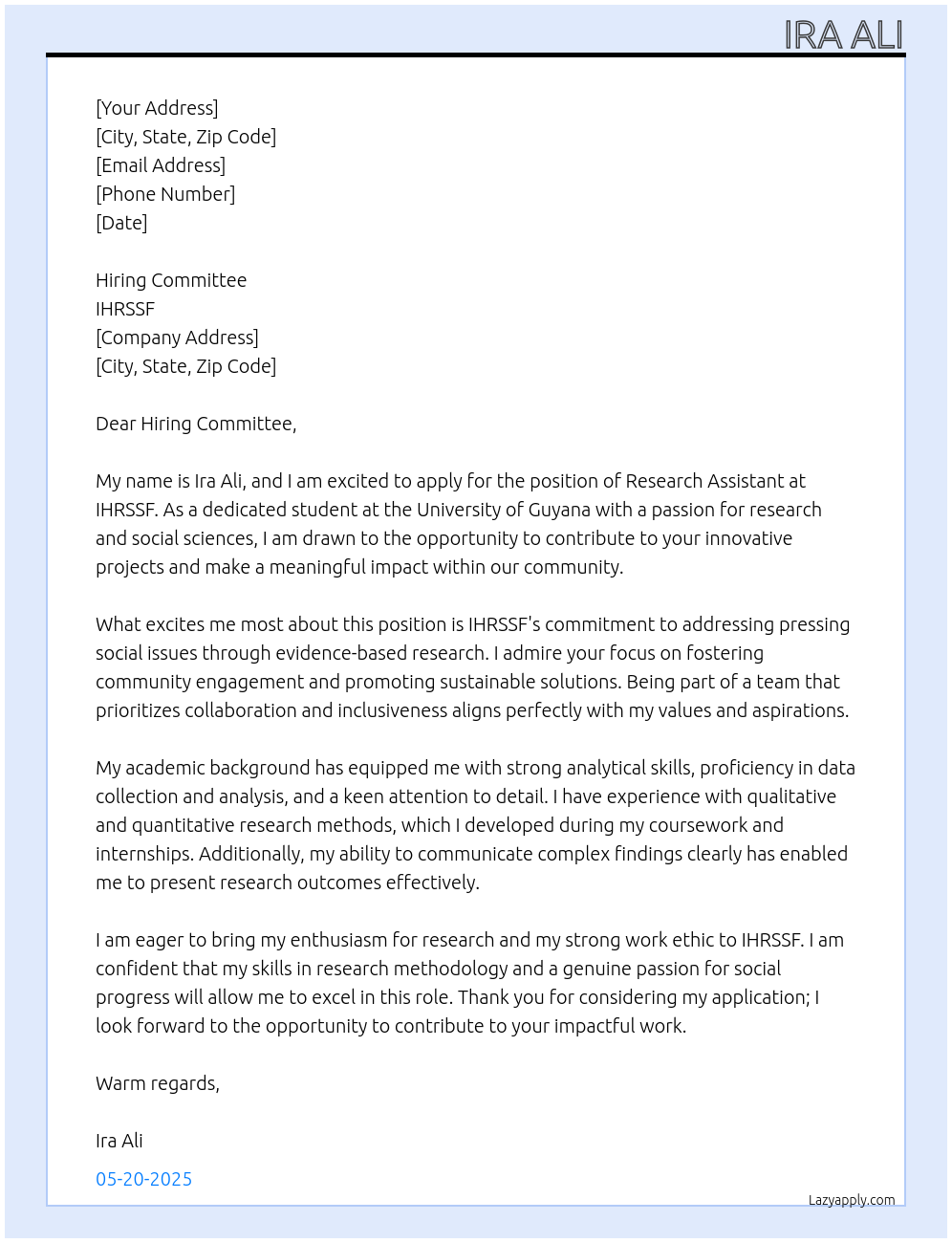
Research Assistant Cover Letter At IHRSSF
IHRSSF
By Ira Ali
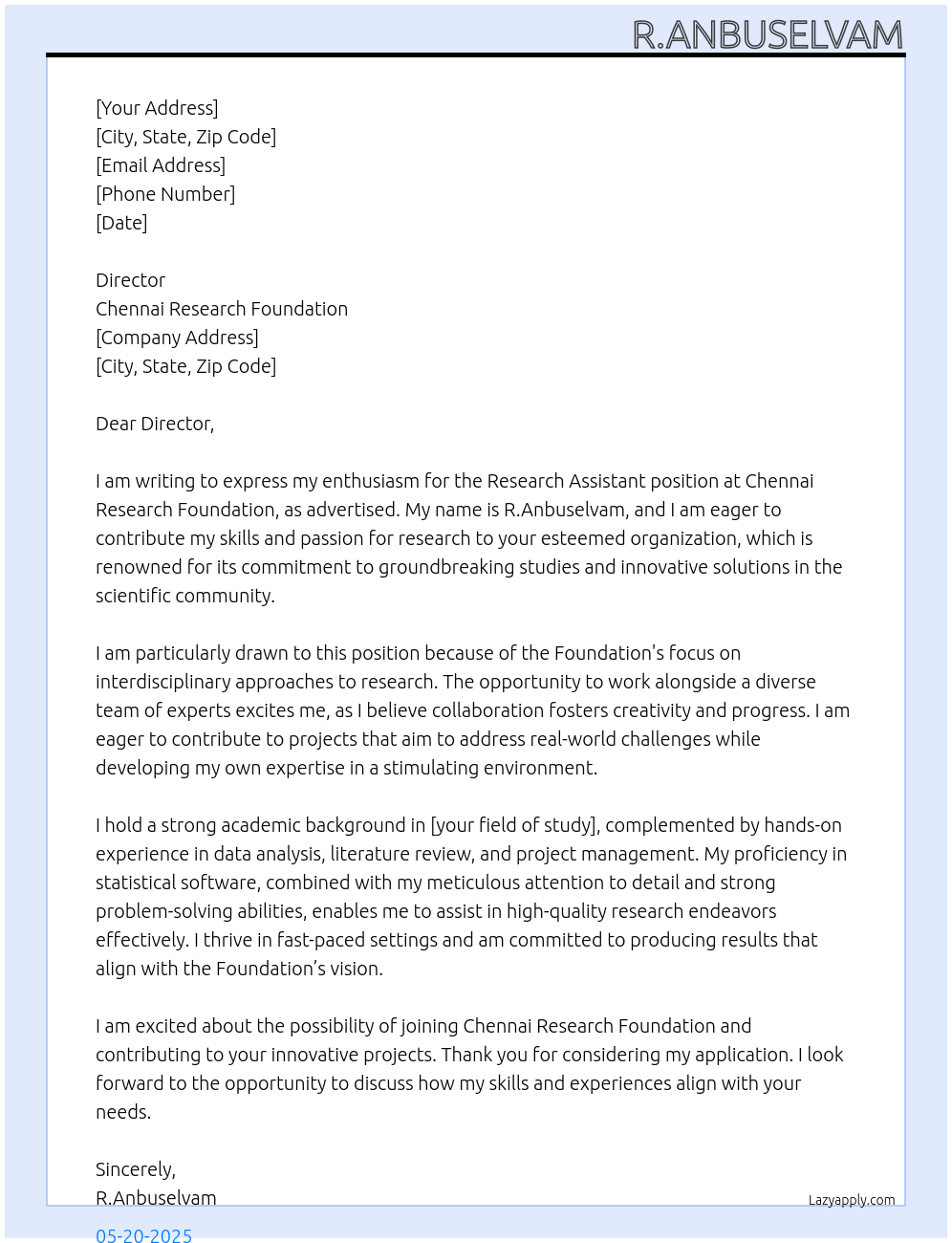
Research Assistant Cover Letter At Chennai Research Foundation
Chennai Research Foundation
By R.Anbuselvam
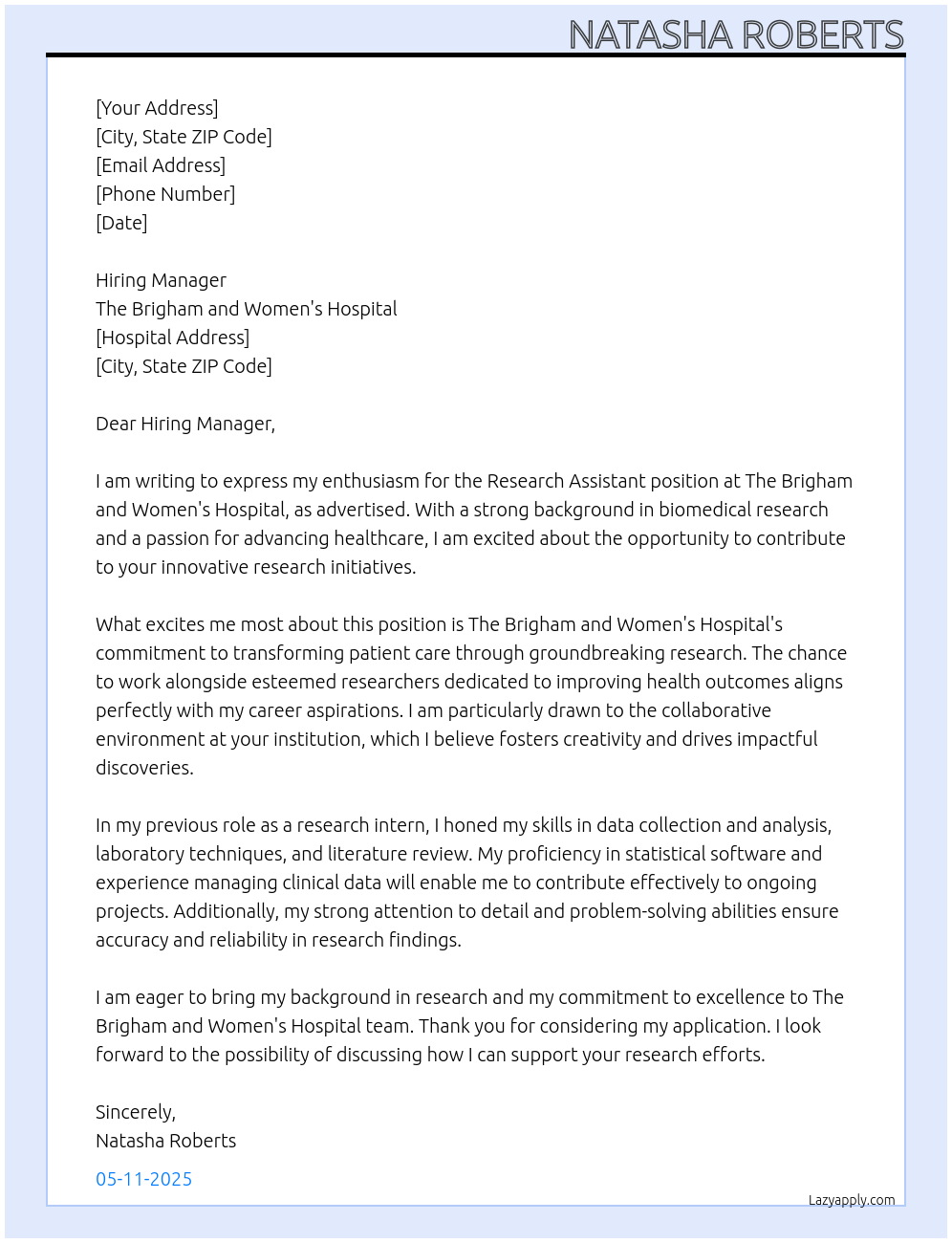
Research Assistant Cover Letter At The Brigham and Women's Hospital
The Brigham and Women's Hospital
By Natasha Roberts
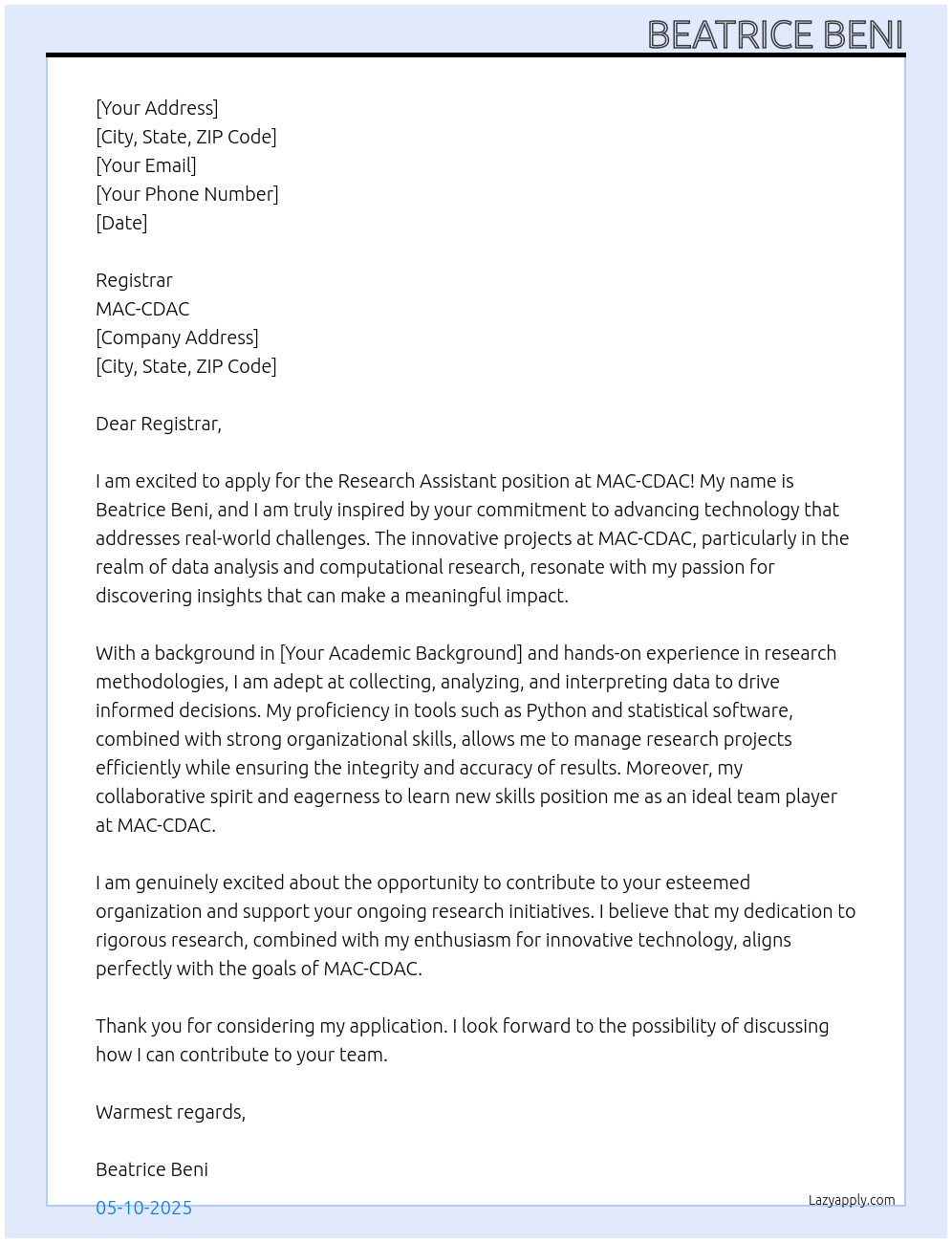
Research assistant Cover Letter At MAC-CDAC
MAC-CDAC
By Beatrice Beni

Research Assistant Cover Letter At Bio Guard
Bio Guard
By S Vanmathi
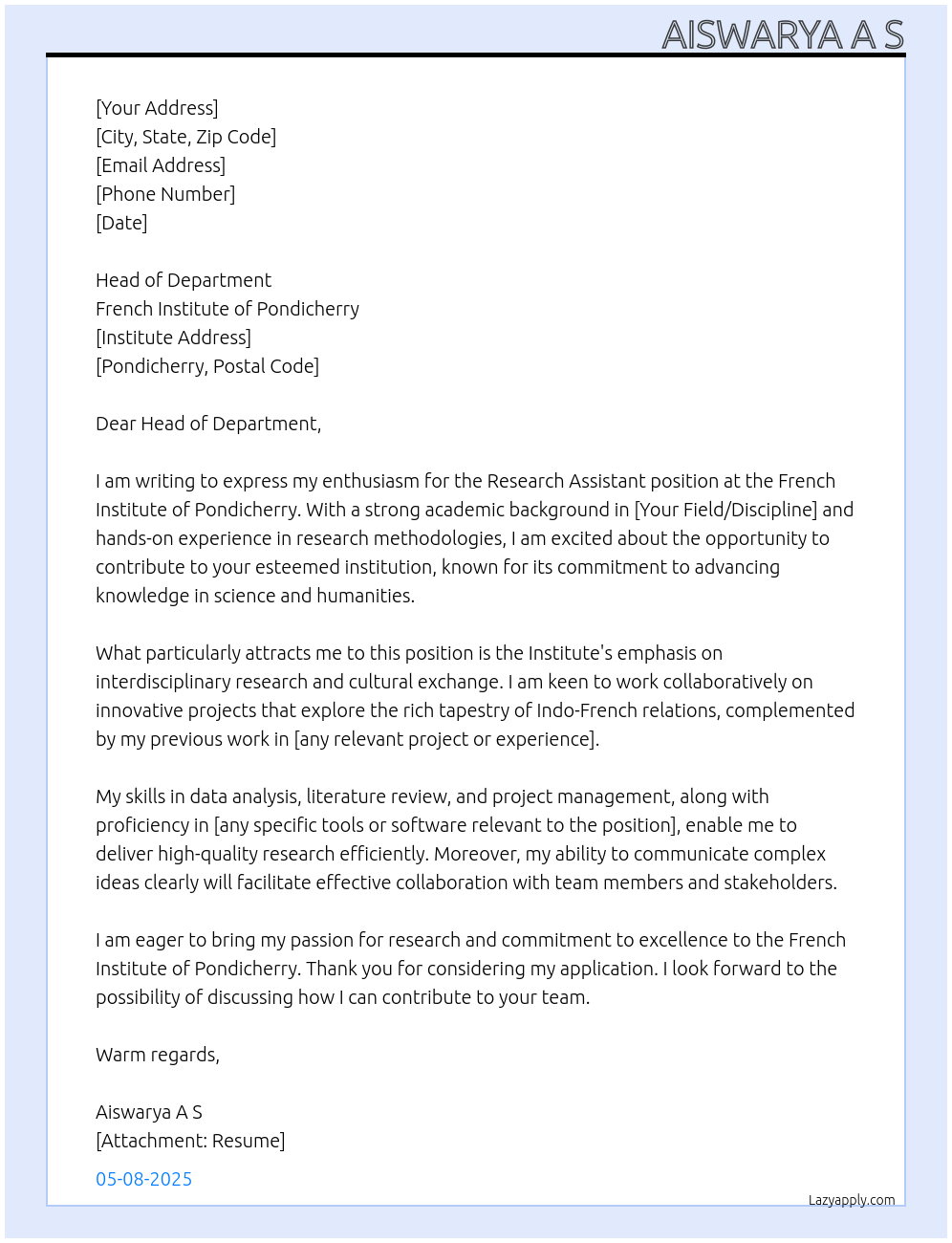
Research assistant Cover Letter At French institute of Pondicherry
French institute of Pondicherry
By Aiswarya A S
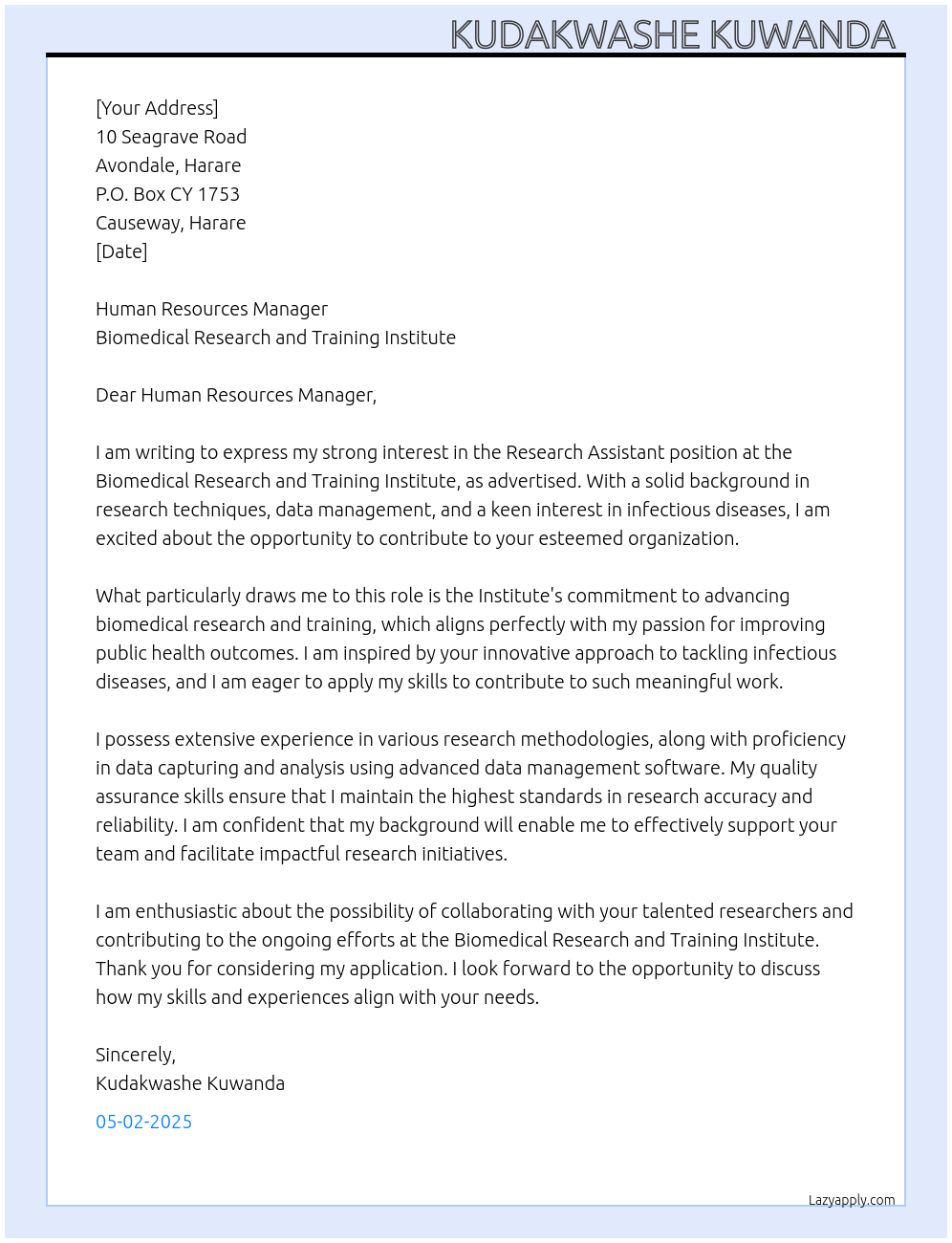
Research Assistant Cover Letter At Biomedical Research and Training Institute
Biomedical Research and Training Institute
10 Seagrave Road Avondale Harare. Box Address: P.O. Box CY 1753 Causeway, Harare
By Kudakwashe Kuwanda

Research Assistant Cover Letter At Infectious Diseases Institute
Infectious Diseases Institute
By Augustine okullo

research assistant Cover Letter At iids
iids
By Laba Jaishi
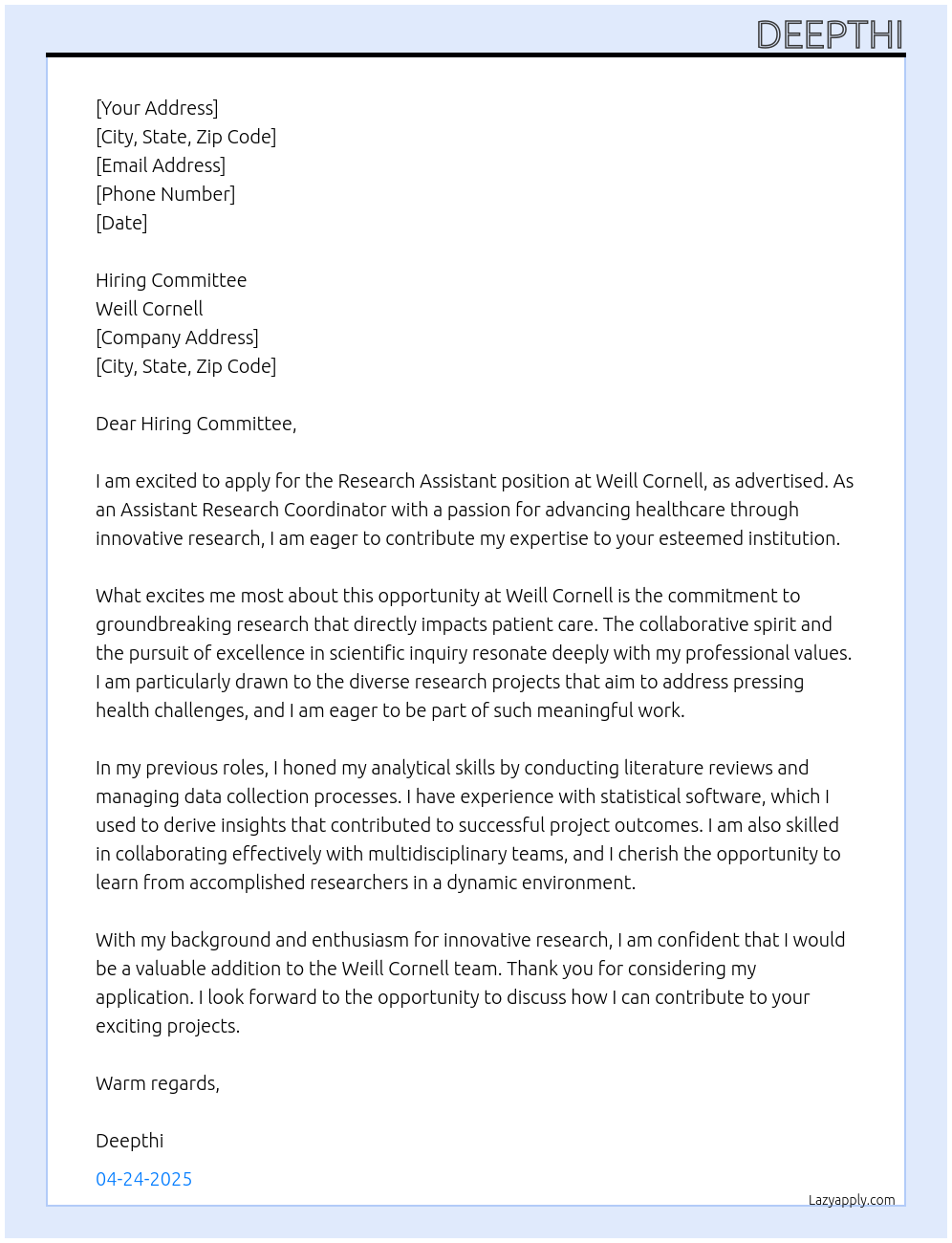
Research assistant Cover Letter At Weill Cornell
Weill Cornell
By Deepthi
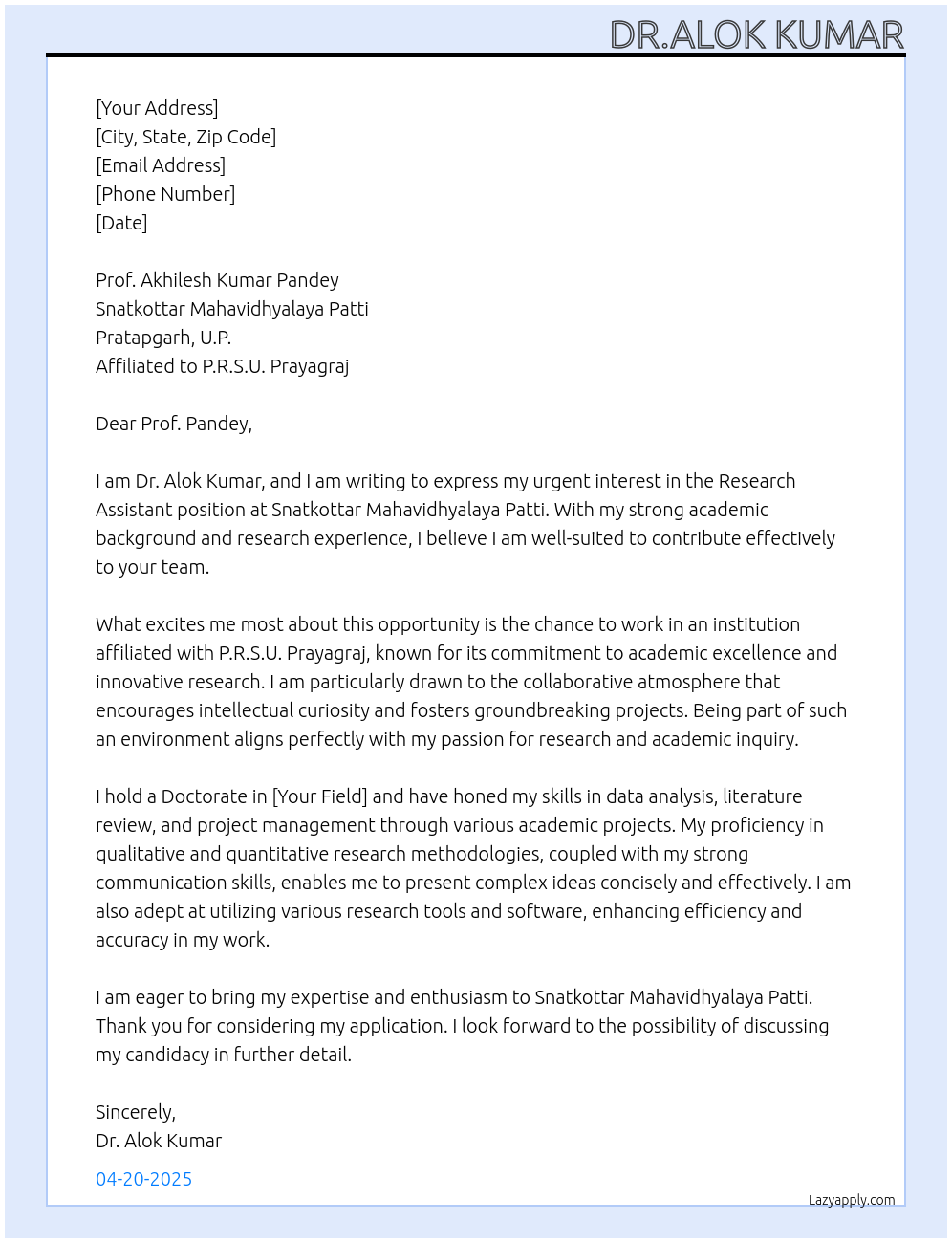
Research Assistant Cover Letter At Snatkottar Mahavidhyalaya Patti, Pratapgarh, U.P. affiliated to P.R.S.U. Prayagraj
Snatkottar Mahavidhyalaya Patti, Pratapgarh, U.P. affiliated to P.R.S.U. Prayagraj
By Dr.Alok Kumar

Research Assistant Cover Letter At summer foundation
summer foundation
By Eebnath Kaiser

Research Assistant Cover Letter At University of Nairobi
University of Nairobi
Nairobi
By Nelly

research assistant Cover Letter At tanjina.ciprb
tanjina.ciprb
By dr.md zulker nayeem

Research Assistant Cover Letter At Coverdalelab
Coverdalelab
By Denis

research assistant Cover Letter At centre for social ecology
centre for social ecology
By Achhay Singh

Research Assistant Cover Letter At Brookings
Brookings
By Claire

Research assistant Cover Letter At Innovations for Development Empowerment And Advancement Strategies
Innovations for Development Empowerment And Advancement Strategies
By Muhindo Frankline
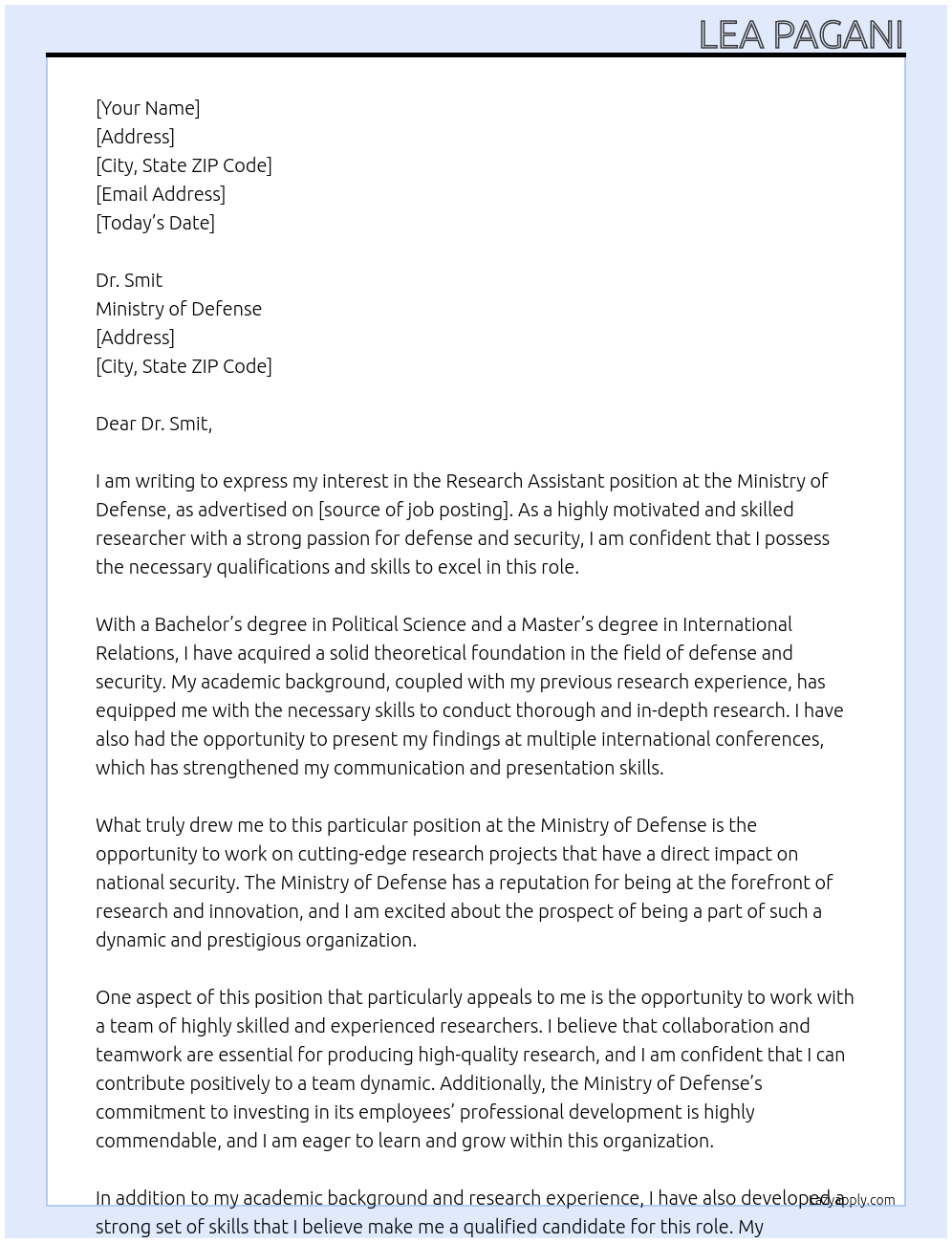
Research Assistant Cover Letter At Ministry of Defense
Ministry of Defense
By Lea Pagani

Research Assistant Cover Letter At UAE University
UAE University
By Fareed

Research Assistant Cover Letter At Wits-Health Consortium (Pty) Ltd is a wholly owned subsidiary of the University of the Witwatersrand. A division of Wits Health Consortium (Pty) Ltd The Wits Health Consortium will only respond to shortlisted candidates. Candidates who have not been contacted within two weeks of the closing date can consider their applications unsuccessful. • Capacitate and mentor Case Navigators to facilitate appropriate linkages to care and support systems between schools, communities, and facilities. • Support the activities of Case Navigators and ensure that they are reported correctly and timeously. • Always maintain client ‘s confidentiality • Document and file accurately all phone calls to clients, interventions, appointments, and other systems for tracking linkages and follow ups • Track district linkages, follow-up visits for clients and the correct implementation of file reviews • Report on blockages that may arise from the continuum – from identifying AGYW in high risk, demand creation, referral to initiation • Liaise
Wits-Health Consortium (Pty) Ltd is a wholly owned subsidiary of the University of the Witwatersrand. A division of Wits Health Consortium (Pty) Ltd The Wits Health Consortium will only respond to shortlisted candidates. Candidates who have not been contacted within two weeks of the closing date can consider their applications unsuccessful. • Capacitate and mentor Case Navigators to facilitate appropriate linkages to care and support systems between schools, communities, and facilities. • Support the activities of Case Navigators and ensure that they are reported correctly and timeously. • Always maintain client ‘s confidentiality • Document and file accurately all phone calls to clients, interventions, appointments, and other systems for tracking linkages and follow ups • Track district linkages, follow-up visits for clients and the correct implementation of file reviews • Report on blockages that may arise from the continuum – from identifying AGYW in high risk, demand creation, referral to initiation • Liaise
By Mathapelo Jessica masemola

Research assistant Cover Letter At Friendship bench
Friendship bench
By Nicole

Research assistant Cover Letter At Bis
Bis
Lilongwe
By Christina msiska

RESEARCH ASSISTANT Cover Letter At BODHI GLOBAL ANALYSIS
BODHI GLOBAL ANALYSIS
By Ahmed Adan

Research Assistant Cover Letter At Bodhi Global Analysis
Bodhi Global Analysis
By Sharley Namasaka

Research assistant Cover Letter At MRA
MRA
By Rabecca Lipenga

Research assistant Cover Letter At Malawi Liverpool welcome trust
Malawi Liverpool welcome trust
By Rabecca Lipenga

research assistant Cover Letter At Vijay lab
Vijay lab
By hoor islam

Research Assistant Cover Letter At Challenges and Possibilities of Crafts and Folk Traditions of Madia Tribe in Contemporary Perspective (with special reference to the south-west region of Chhattisgarh)
Challenges and Possibilities of Crafts and Folk Traditions of Madia Tribe in Contemporary Perspective (with special reference to the south-west region of Chhattisgarh)
By Angaja Khankeriyal

Research Assistant Cover Letter At SoS in Literature and Languages, Pandit Ravishankar Shukla University
SoS in Literature and Languages, Pandit Ravishankar Shukla University
By Angaja Khankeriyal

Research assistant Cover Letter At Evolution Research Group
Evolution Research Group
By Aalia Tashfeen

Research assistant Cover Letter At Zakir hussain Delhi college
Zakir hussain Delhi college
By AJAY KUMAR YADAV

Research Assistant Cover Letter At Dept of Clinical Neurosciences University of Cambridge Clifford Allbutt Building Cambridge Biosciences Campus Hills Road, CB2 0HA Cambridge (UK) Pluchino Lab Regenerative Neuroimmunology
Dept of Clinical Neurosciences University of Cambridge Clifford Allbutt Building Cambridge Biosciences Campus Hills Road, CB2 0HA Cambridge (UK) Pluchino Lab Regenerative Neuroimmunology
By Melike Cansel EREN

Research assistant Cover Letter At University of Surrey
University of Surrey
By Sarah Riyas

Research Assistant Cover Letter At Teva
Teva
By Yee Farn

Research Assistant Cover Letter At Rotterdam University
Rotterdam University
By Anna

Research assistant Cover Letter At UN
UN
By Inés Segovia

Research assistant Cover Letter At ISRO
ISRO
By Vincy Theresa KV

Research Assistant Cover Letter At Urban Institute
Urban Institute
By Trenton Marbois

Research Assistant Cover Letter At Company
Company
By Mirianna Acevedo

research assistant Cover Letter At The University of chicago
The University of chicago
By Nofisat Segun-Akadiri

research assistant Cover Letter At Unoversity
Unoversity
By Yuen

Research Assistant Cover Letter At OECD
OECD
By OBAIKE JOHN OJEKA

Research Assistant Cover Letter At NYU Rory Meyers College of Nursing
NYU Rory Meyers College of Nursing
NYU Meyers
By Akaash Mohan Saxena

Research assistant Cover Letter At Catholic medical mission board
Catholic medical mission board
By Christine Karanja
